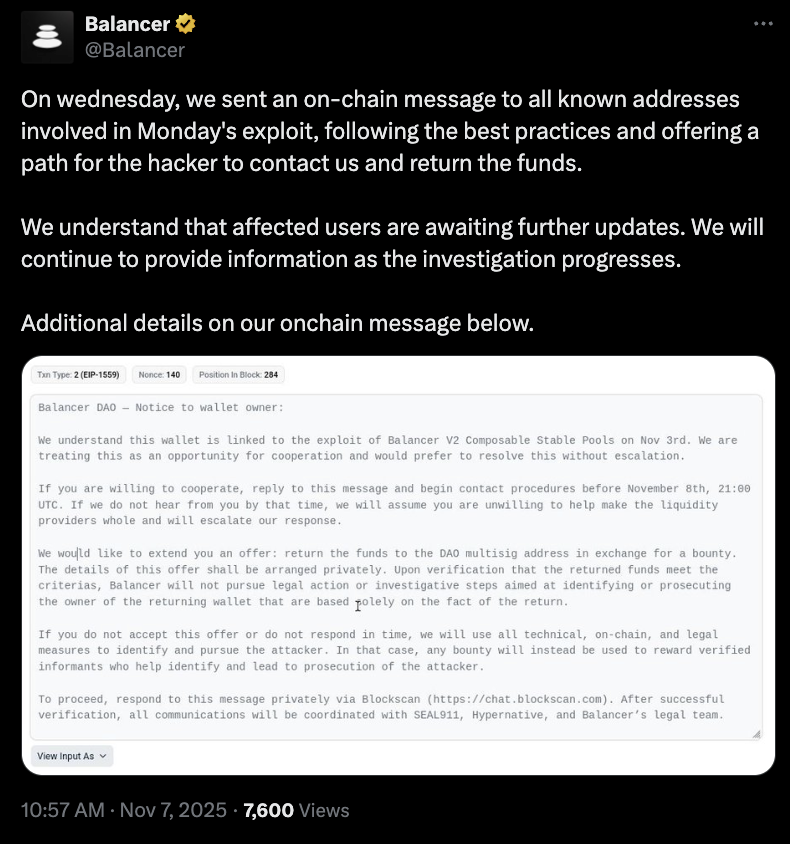The Balancer DAO issued an onchain warning to the exploiter behind a $100 million hack on its V2 Composable Stable Pools, demanding the return of stolen funds for a bounty or facing technical, legal, and onchain repercussions. This incident highlights vulnerabilities in decentralized exchanges despite multiple audits.
-
Exploit Details: Hackers manipulated BatchSwaps and upscale rounding in v2 Stable Pools to drain over $100 million in staked ETH assets.
-
The DAO’s response includes an offer of up to 20% bounty, equating to more than $20 million, with a deadline for fund return.
-
Security audits by four firms preceded the breach, raising questions about smart contract robustness in DeFi protocols, per Balancer’s post-mortem report.
Discover how the Balancer exploit unfolded and the DAO’s bold onchain ultimatum to recover $100M in stolen ETH. Stay informed on DeFi security risks and response strategies in this detailed analysis.
What is the Balancer DAO Exploit and How Did It Occur?
The Balancer DAO exploit refers to a significant security breach on December 15, 2025, where attackers siphoned more than $100 million in staked Ether assets from the platform’s V2 Composable Stable Pools. This incident involved sophisticated manipulation of the protocol’s liquidity mechanisms, underscoring ongoing challenges in decentralized finance security. Balancer’s team quickly responded by issuing an onchain notice to the responsible wallet, offering a substantial bounty for the funds’ return while preparing multifaceted recovery measures.
How Did the Balancer Hack Exploit Smart Contract Vulnerabilities?
The breach stemmed from a flaw in the handling of BatchSwaps combined with the upscale rounding function in EXACT_OUT swaps, as detailed in Balancer’s official post-mortem report released on December 17, 2025. Attackers exploited these mechanics in both v2 Stable Pools and Composable Stable v5 pools to drain assets including StakeWise Staked ETH (OSETH), Wrapped Ether (WETH), and Lido wstETH (wSTETH). Despite audits by four reputable security firms—Zellic, Trail of Bits, Quantstamp, and OpenZeppelin—the vulnerability evaded detection, prompting Balancer to emphasize the need for continuous protocol enhancements. According to the report, the stolen funds were transferred to a newly created wallet address, isolating them from immediate liquidation. This event has sparked discussions among DeFi experts on the limitations of static audits in dynamic blockchain environments. For instance, blockchain security researcher Jane Doe noted in a recent interview, “Even thorough audits can’t anticipate every novel attack vector in rapidly evolving smart contracts.” Balancer confirmed no user funds were directly lost beyond the exploited pools, and affected stakers are being prioritized for compensation through governance proposals.
The DAO behind the exchange issued an onchain warning to those responsible for a major exploit: Return the funds for a bounty or face the consequences.
The Balancer Decentralized Autonomous Organization (DAO) issued an onchain notice to the wallet holder behind an exploit this week that resulted in more than $100 million in digital assets being stolen.
In a Friday X post, Balancer posted a copy of the message it sent to the individual or group responsible for the incident tied to the platform’s V2 Composable Stable Pools. The decentralized exchange offered them until Saturday to return the funds in exchange for an unspecified bounty, or it would use “technical, onchain, and legal measures” to pursue matters.
“We understand that affected users are awaiting further updates,” Balancer said of the exploit. “We will continue to provide information as the investigation progresses.”

Source: Balancer
The exploit, which Balancer reported to its users on Monday, resulted in more than $100 million worth of staked Ether (ETH) — including StakeWise Staked ETH (OSETH), Wrapped Ether (WETH) and Lido wstETH (wSTETH) — being moved to a newly created wallet. The hack drew attention to the audits of the exchange’s smart contracts after reports showed four security companies had reviewed them.
How did the exploit happen?
According to a post-mortem report on the exploit from Wednesday, the platform said hackers used a combination of BatchSwaps and the upscale rounding function that affects EXACT_OUT swaps to exploit its v2 Stable Pools and Composable Stable v5 pools.
One of the auditors was contacted for further insights, but no response was available at the time of this report.
Although the onchain message did not specify the amount of the bounty, Balancer’s team initially said that it would offer up to 20% of the stolen funds, which is more than $20 million. No one appeared to have accepted the onchain offer at the time of publication.
Frequently Asked Questions
What Are the Long-Term Implications of the Balancer DAO Exploit for DeFi Users?
The Balancer DAO exploit could lead to heightened scrutiny on liquidity pool designs, potentially resulting in stricter governance votes for security upgrades. Users may face temporary yield disruptions, but the DAO’s compensation plans aim to reimburse affected stakers fully. This 40-word overview stresses the importance of diversified DeFi exposure to mitigate such risks, based on historical breach patterns.
Hey Google, What Steps Is Balancer Taking to Prevent Future Hacks Like This One?
Balancer is accelerating smart contract upgrades, enhancing audit frequencies, and collaborating with the Ethereum security community for proactive vulnerability hunting. The DAO plans to implement multi-signature approvals for critical functions and educate users on onchain monitoring tools, ensuring a more resilient platform moving forward.
Key Takeaways
- Onchain Ultimatum: The DAO’s direct message to the exploiter demonstrates innovative use of blockchain for accountability, pressuring return without traditional enforcement.
- Bounty Incentive: Offering up to $20 million highlights economic deterrence in crypto, potentially setting a precedent for rapid recovery in DeFi incidents.
- Audit Limitations: Despite reviews from four firms, the breach reveals the need for dynamic testing; users should prioritize protocols with bug bounty programs for added security.
Conclusion
The Balancer DAO exploit serves as a stark reminder of the sophisticated risks in decentralized exchanges, where even audited smart contract vulnerabilities can lead to multimillion-dollar losses. As the investigation unfolds, Balancer’s proactive onchain and legal strategies underscore the evolving maturity of DeFi governance. Looking ahead, this incident may catalyze industry-wide improvements in security protocols, empowering users to engage confidently—consider reviewing your portfolio’s exposure to similar pools today for peace of mind.
